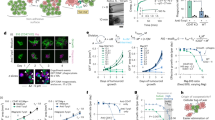Abstract
When injected i.p. and in large numbers (10(7)) into syngeneic mice, 125IUdR-labelled L1210 cells are rapidly destroyed in a small proportion of animals, while in the other animals the lysis is low. This bimodal distribution is clearly visible 24 h after cell injection. The intense lysis occurs in fewer animals when macrophage-derived lysosomal enzymes are inhibited by trypan blue and if the complement is depleted by high doses of cobra venom factor (CVF). The intense destruction occurs in more animals after adjuvant treatment, if the mice are latently contaminated, after a moderate production of C3b by low doses of CVF, or after the injection of a tumour-cell dialysate. The destruction seems to be the result of positive feedback reaction which involves at least macrophages and complement activation.
This is a preview of subscription content, access via your institution
Access options
Subscribe to this journal
Receive 24 print issues and online access
$259.00 per year
only $10.79 per issue
Buy this article
- Purchase on Springer Link
- Instant access to full article PDF
Prices may be subject to local taxes which are calculated during checkout
Similar content being viewed by others

Rights and permissions
About this article
Cite this article
Orbach-Arbouys, S., Lheritier, J., Allouche, M. et al. Intense tumour-cell destruction by syngeneic mice: role of macrophages, complement activation and tumour-cell factors. Br J Cancer 36, 743–750 (1977). https://doi.org/10.1038/bjc.1977.257
Issue Date:
DOI: https://doi.org/10.1038/bjc.1977.257


